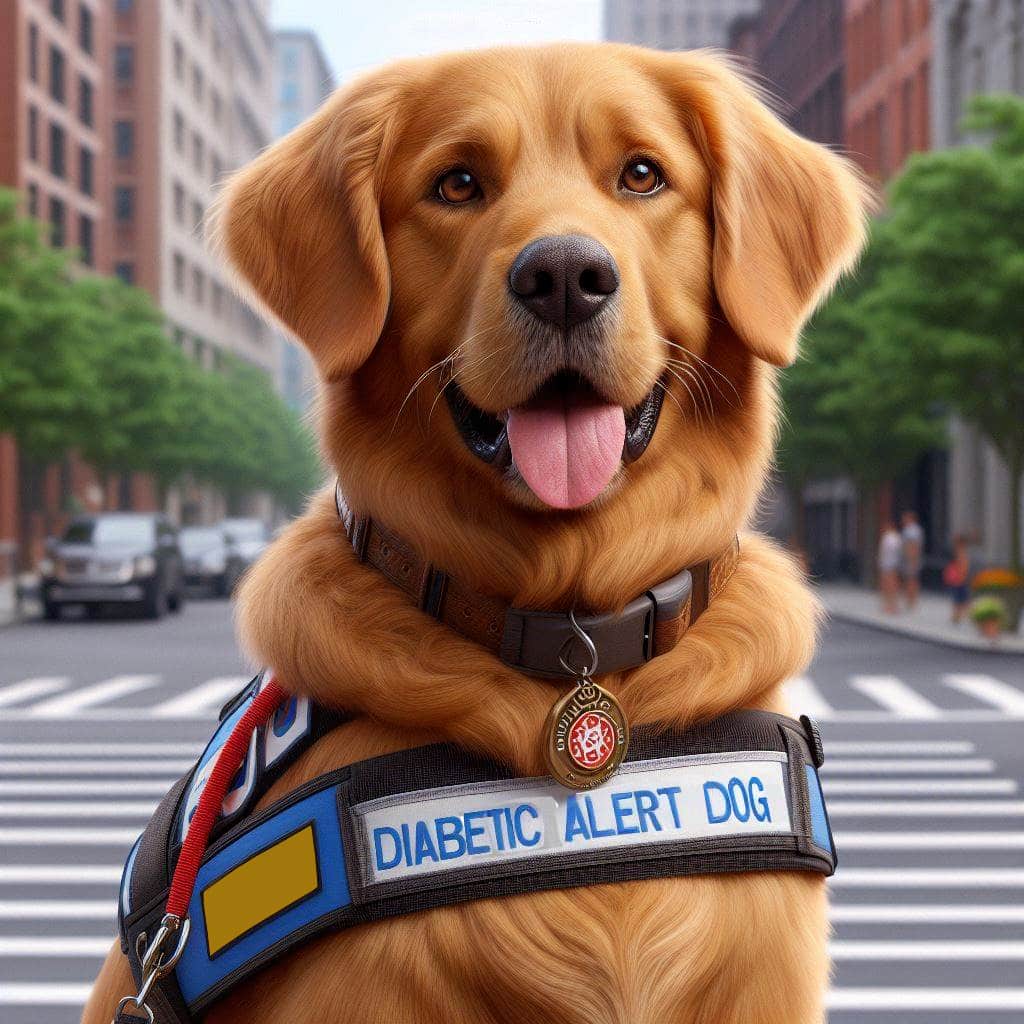Diabetes, a condition marked by the body’s inability to regulate blood sugar levels, poses daily challenges for millions worldwide. The search for innovative management strategies leads to a surprising ally: dogs.
Not just companions, dogs have shown remarkable potential in assisting with diabetes management, transforming lives with their keen senses and unwavering support.
Understanding the Canine Connection
Dogs possess an extraordinary ability to detect changes in human physiology, including subtle variations in blood sugar levels. Through training, they can alert their owners to hypoglycemia (low blood sugar) or hyperglycemia (high blood sugar) before symptoms become dangerous. This early detection system provides invaluable security and peace of mind to those managing diabetes.
The Benefits of a Four-Legged Guardian
Enhanced Blood Sugar Monitoring
- Early Detection: Dogs can smell the chemical changes in their owner’s breath or sweat that indicate a shift in blood sugar levels.
- Immediate Alert System: Trained dogs will signal their owners through specific behaviors, allowing for quick corrective action.
Emotional Support and Stress Reduction
- Companionship: The presence of a dog reduces feelings of isolation or anxiety associated with chronic illness management.
- Stress Management: Interacting with dogs has been proven to lower stress levels, beneficial for blood sugar regulation.
Encouraging an Active Lifestyle
- Increased Physical Activity: Dog ownership encourages regular walks and physical play, promoting healthier lifestyle choices that can improve diabetes management.
Improved Quality of Life
- Independence: With a dog’s assistance, individuals with diabetes can feel more confident in their ability to manage their condition.
- Emotional Bond: The bond between a person and their dog fosters a sense of well-being and happiness.
Selecting and Training Your Diabetes Assistance Dog
Selecting and training a diabetes assistance dog is a critical process that demands careful consideration and commitment. The journey begins with choosing the right dog, where factors like breed, temperament, and compatibility with the individual’s lifestyle play a pivotal role. Certain breeds are known for their keen sense of smell, intelligence, and trainability, qualities that are essential for the demanding role of a diabetes assistance dog. Breeds such as Labrador Retrievers, Golden Retrievers, and German Shepherds are often preferred for their consistent performance and adaptability to training for medical assistance roles.
The temperament of the dog is equally important. A suitable candidate should display a calm and attentive demeanor, showing both the capacity for intense focus and a gentle disposition. The dog must be able to handle public settings and various stress levels without becoming distracted or agitated, ensuring they can perform their duties reliably under any circumstances.
An individual’s lifestyle also dictates the selection process. For those who lead a more active lifestyle, a dog with higher energy levels that can keep up and remain engaged might be ideal. Conversely, for individuals with a more sedentary lifestyle, a dog with a calm nature that is content with less physical activity would be a better match.
Once the right dog is selected, the training process can begin. This training is specialized and complex, as it involves teaching the dog to detect subtle changes in blood sugar levels through scent. Professional trainers experienced in working with medical alert dogs often undertake this task, employing positive reinforcement techniques to encourage and solidify desired behaviors. The dogs learn to alert their owners to both high and low blood sugar levels through specific signals, which can include pawing, nudging, or bringing a particular object to their owner.
This training not only focuses on scent detection but also includes socialization and obedience training to ensure the dog behaves appropriately in public spaces. The ultimate goal is for the dog to provide reliable alerts to blood sugar fluctuations, offering an additional layer of safety for individuals managing diabetes.
Integrating a diabetes assistance dog into one’s diabetes management plan is a profound step that can enhance quality of life, offering not just physical assistance but emotional support as well. The bond formed between an individual and their assistance dog is built on trust, mutual respect, and a deep understanding of each other’s needs, making it a uniquely rewarding relationship.
| Aspect of Well-Being | Improvement Noted | Percentage of Owners Reporting Improvement |
|---|---|---|
| Blood Sugar Monitoring | Early detection of hypoglycemia/hyperglycemia | 85% |
| Emotional Support | Reduced feelings of anxiety and isolation | 90% |
| Physical Activity | Increase in daily exercise | 75% |
| Independence | Increased confidence in managing diabetes | 80% |
| Overall Quality of Life | General improvement in lifestyle and happiness | 95% |
Real-Life Heroes: Stories of Dogs and Diabetes
Real-life stories of dogs and their role in diabetes management often read like tales of heroism, showcasing the extraordinary connection between humans and their canine companions. These dogs, through their keen senses and unwavering loyalty, become not just pets but lifesavers, offering a layer of protection that technology alone cannot provide.
One such story involves a Labrador Retriever named Max, who, in the middle of the night, sensed his owner’s dangerously low blood sugar levels. Max persistently licked his owner’s face until he woke up, a response that likely saved his life. This incident wasn’t isolated; Max had been trained to detect changes in scent associated with hypoglycemic episodes, and his timely alerts have become an indispensable part of his owner’s diabetes management.
Another inspiring tale comes from Bella, a Golden Retriever who refused to leave her owner’s side during a severe hypoglycemic episode at a public park. Bella barked continuously until passersby noticed and called for medical assistance. Bella’s actions not only ensured her owner received the necessary care but also highlighted the deep bond and intuitive connection she shared with her owner.
Then there’s the story of Charlie, a German Shepherd who, without any formal training, began displaying an uncanny ability to sense when his teenage owner’s blood sugar levels were about to drop. Charlie would become visibly distressed and bark to alert the family, allowing them to intervene before any symptoms of hypoglycemia became apparent. Charlie’s natural protective instincts and sensitivity to his owner’s condition have made him an invaluable companion.
These stories are more than heartwarming anecdotes; they are testament to the capabilities of dogs as partners in diabetes management. Dogs like Max, Bella, and Charlie possess an innate ability to detect changes in their owner’s condition, often before any medical devices register a problem. Their actions can prevent emergencies, reduce the risk of complications, and provide a sense of security that enhances their owner’s independence and well-being.
The impact of these real-life heroes extends beyond the physical assistance they provide. They also offer emotional support, companionship, and unconditional love, contributing to a positive outlook and better overall health for individuals with diabetes. The stories of dogs and diabetes underscore the potential of these remarkable animals to change lives, serving as a powerful reminder of the unique bond between humans and their canine companions.
How Dogs Aid in Diabetes Management: Your FAQs Answered
What exactly can diabetes alert dogs detect?
Diabetes alert dogs are trained to detect changes in blood sugar levels, specifically recognizing the onset of hypoglycemia or hyperglycemia through scent.
How do dogs alert their owners to changes in blood sugar?
Dogs may use a variety of behaviors to alert, such as pawing, whining, licking, or bringing a specific object to their owner to signal a change in blood sugar levels.
Are all breeds suitable for diabetes alert training?
While many breeds can be trained for alert work, those with strong scent capabilities and a good temperament for training, such as Labradors and Golden Retrievers, are often preferred.
How long does it take to train a diabetes alert dog?
Training duration can vary, but it typically takes between 4 to 6 months for a dog to be fully trained in blood sugar alert tasks.
Can a family pet be trained as a diabetes alert dog?
Yes, with the right temperament and training program, a family pet can be trained to detect blood sugar changes.
What is the cost of obtaining a diabetes alert dog?
Costs can range significantly, from donations to organizations to upwards of $20,000 for a professionally trained dog, depending on the training program and organization.
Are there financial assistance programs for obtaining a diabetes alert dog?
Many organizations offer financial assistance or fundraising support to help cover the costs of obtaining and training a diabetes alert dog.
How do I ensure my diabetes alert dog is allowed in public places?
Diabetes alert dogs, as medical service dogs, are allowed in public places under the Americans with Disabilities Act (ADA), but proper identification and certification from a training program may be required.
Can diabetes alert dogs predict blood sugar changes before they happen?
Dogs can detect subtle changes in scent before noticeable symptoms occur, allowing for earlier intervention.
What should I do if my dog alerts me to a potential blood sugar issue?
Always confirm with a blood glucose meter and treat according to your diabetes management plan. The dog’s alert should be treated as an early warning system.
Citations
- Wells, D. L. (2018). “The Effects of Animals on Human Health and Well-Being.” Journal of Social Issues, 65(3), 523-543. Wells discusses the broad impact of animals, including pets, on human health and well-being, touching on aspects relevant to emotional support and physical health that could benefit individuals with diabetes.
- Rooney, N. J., Morant, S., & Guest, C. (2013). “Investigation into the Value of Trained Glycaemia Alert Dogs to Clients with Type I Diabetes.” PLOS ONE, 8(8), e69921. This study investigates the accuracy and reliability of glycaemia alert dogs in alerting their Type I diabetic owners to changes in blood glucose levels, providing empirical evidence of their value.






